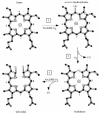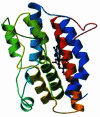Iron transport systems in Neisseria meningitidis
- PMID: 15007100
- PMCID: PMC362107
- DOI: 10.1128/MMBR.68.1.154-171.2004
Iron transport systems in Neisseria meningitidis
Abstract
Acquisition of iron and iron complexes has long been recognized as a major determinant in the pathogenesis of Neisseria meningitidis. In this review, high-affinity iron uptake systems, which allow meningococci to utilize the human host proteins transferrin, lactoferrin, hemoglobin, and haptoglobin-hemoglobin as sources of essential iron, are described. Classic features of bacterial iron transport systems, such as regulation by the iron-responsive repressor Fur and TonB-dependent transport activity, are discussed, as well as more specific features of meningococcal iron transport. Our current understanding of how N. meningitidis acquires iron from the human host and the vaccine potentials of various components of these iron transport systems are also reviewed.
Figures




Similar articles
-
Structural insight into the lactoferrin receptors from pathogenic Neisseria.J Struct Biol. 2013 Oct;184(1):83-92. doi: 10.1016/j.jsb.2013.02.009. Epub 2013 Feb 24. J Struct Biol. 2013. PMID: 23462098 Free PMC article.
-
HmbR outer membrane receptors of pathogenic Neisseria spp.: iron-regulated, hemoglobin-binding proteins with a high level of primary structure conservation.J Bacteriol. 1996 Aug;178(15):4670-8. doi: 10.1128/jb.178.15.4670-4678.1996. J Bacteriol. 1996. PMID: 8755899 Free PMC article.
-
Analysis of haptoglobin and hemoglobin-haptoglobin interactions with the Neisseria meningitidis TonB-dependent receptor HpuAB by flow cytometry.Infect Immun. 2004 May;72(5):2494-506. doi: 10.1128/IAI.72.5.2494-2506.2004. Infect Immun. 2004. PMID: 15102756 Free PMC article.
-
Response of Neisseria meningitidis to iron limitation.Antonie Van Leeuwenhoek. 1997 Feb;71(1-2):129-36. doi: 10.1023/a:1000179301748. Antonie Van Leeuwenhoek. 1997. PMID: 9049024 Review.
-
Mechanisms of iron acquisition by the human pathogens Neisseria meningitidis and Neisseria gonorrhoeae.Front Biosci. 2003 Sep 1;8:d1186-218. doi: 10.2741/1133. Front Biosci. 2003. PMID: 12957813 Review.
Cited by
-
Evolutionary relationships of Fusobacterium nucleatum based on phylogenetic analysis and comparative genomics.BMC Evol Biol. 2004 Nov 26;4:50. doi: 10.1186/1471-2148-4-50. BMC Evol Biol. 2004. PMID: 15566569 Free PMC article.
-
Transcriptome analysis of Neisseria meningitidis in human whole blood and mutagenesis studies identify virulence factors involved in blood survival.PLoS Pathog. 2011 May;7(5):e1002027. doi: 10.1371/journal.ppat.1002027. Epub 2011 May 5. PLoS Pathog. 2011. PMID: 21589640 Free PMC article.
-
Phase variation mediates reductions in expression of surface proteins during persistent meningococcal carriage.Infect Immun. 2014 Jun;82(6):2472-84. doi: 10.1128/IAI.01521-14. Epub 2014 Mar 31. Infect Immun. 2014. PMID: 24686058 Free PMC article.
-
Genomic and global approaches to unravelling how hypermutable sequences influence bacterial pathogenesis.Pathogens. 2014 Feb 25;3(1):164-84. doi: 10.3390/pathogens3010164. Pathogens. 2014. PMID: 25437613 Free PMC article. Review.
-
Adhesion of Neisseria meningitidis to dermal vessels leads to local vascular damage and purpura in a humanized mouse model.PLoS Pathog. 2013 Jan;9(1):e1003139. doi: 10.1371/journal.ppat.1003139. Epub 2013 Jan 24. PLoS Pathog. 2013. PMID: 23359320 Free PMC article.
References
-
- Ala'Aldeen, D. A. 1996. Transferrin receptors of Neisseria meningitidis: promising candidates for a broadly cross-protective vaccine. J. Med. Microbiol. 44:237-243. - PubMed
-
- Ala'Aldeen, D. A., and S. P. Borriello. 1996. The meningococcal transferrin-binding proteins 1 and 2 are both surface exposed and generate bactericidal antibodies capable of killing homologous and heterologous strains. Vaccine 14:49-53. - PubMed
-
- Alcantara, J., R. H. Yu, and A. B. Schryvers. 1993. The region of human transferrin involved in binding to bacterial transferrin receptors is localized in the C-lobe. Mol. Microbiol. 8:1135-1143. - PubMed
Publication types
MeSH terms
Substances
Grants and funding
LinkOut - more resources
Full Text Sources
Other Literature Sources
Medical

